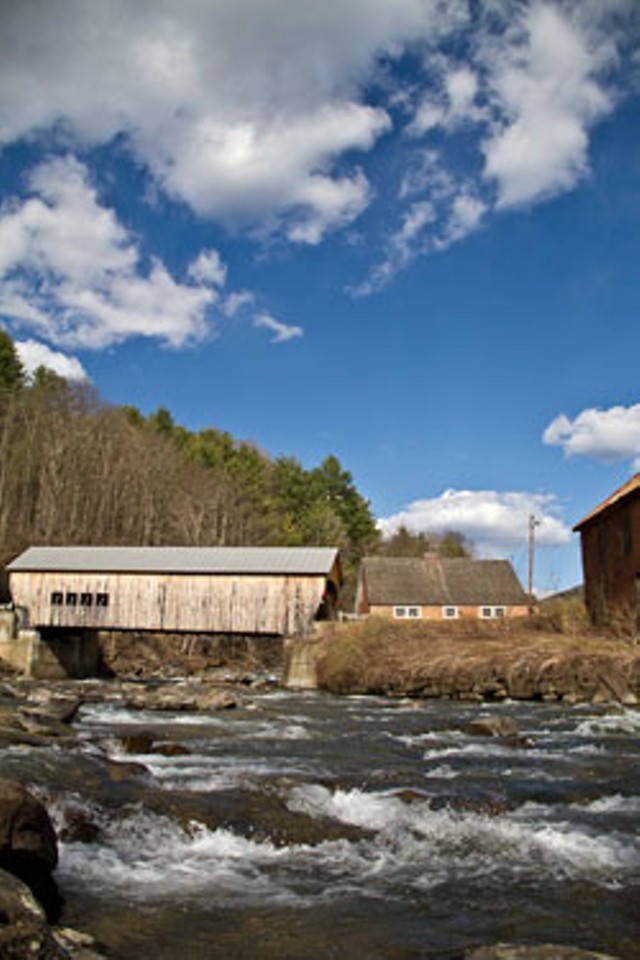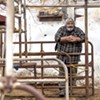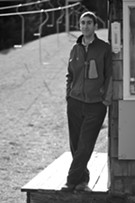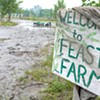Published April 21, 2010 at 5:59 a.m.
Daan Wensing is a quick study. Since October 2009, the Dutchman has been making periodic visits to Vermont, trying to understand just what makes this place special. On a recent day when deep blue sky is punctuated by puffy clouds, rivers run clean and cold, and the pastured hills burn green under the sun, he sums up what he’s learned: “Vermont has no billboards because its landscape is its billboard.”
It’s not the first time a guy from the Netherlands has been awed by the natural beauty of the New World. Three hundred and eighty-four years ago, in fact, Peter Minuit was so impressed by the sylvan grandeur of Manhattan that he offered to buy it from the Native Americans on the spot. Flattered by his overture, and not really familiar with the concept of private property, they sold the island to him for a bundle of goods worth about 24 bucks.
Wensing, who bears a boyish resemblance to Matt Damon, isn’t here to fleece the locals. He wants to help them keep Vermont the way it is. He and some colleagues at an Amsterdam-based company, Triple-E, developed a conservation tool called a “landscape auction” to aid people in rural parts of the Netherlands in maintaining their agricultural setting. The auction system basically enables citizens and businesses to “adopt” a landscape element — such as an open field or a walking trail — by paying for its creation or maintenance for a given period.
This is not just a crunchy version of “Adopt-a-Highway,” but a way for a community to get together and give voice to its values. And it’s been surprisingly effective — the first European auction, in 2007, raised $200,000 in just 45 minutes.
Now Wensing is trying to do the same thing for the landscapes conserved by the White River Partnership (WRP), a nonprofit organization in South Royalton. In late August, people will have the opportunity to bid on items such as improving habitat for neotropical migratory songbirds and renting a bus so schoolkids can visit a farm.
According to WRP executive director Mary Russ, the organization’s goal is “to bring people together to improve the long-term health of the White River watershed and the landscape between its rivers.” The landscape auction is one step in a process that began back in 1995, when the WRP was founded. That’s also when administrators of the Green Mountain National Forest began researching how they could manage their public land through a watershed model.
Thinking about conservation and resource protection in terms of watersheds — areas of land where all the water flows downhill to the same river — is relatively new in Vermont. The concept is this: To gauge the health and sustainability of land-use patterns, look at the water quality of streams and rivers adjacent to that land.
The WRP started as a group of local farmers, fishermen and business owners who wanted to maintain the quality of life in the White River watershed, which covers 710 square miles in central Vermont. It blossomed into an official nonprofit in 2000, after receiving a generous grant from the United States Forest Service. Today, the WRP offers a broad range of services, from water-quality monitoring to river- restoration programs and watershed education.
By all accounts, the WRP’s work has gone, well, swimmingly. The water quality of the 56-mile-long main stem of the White River and its numerous branches is “fishable/swimmable,” an EPA gold standard. “Almost all the tributaries,” says board member and fly-fishing guide Ron Rhodes, “support wild brook trout, and if you don’t have clean, cold water, brook trout can’t survive.”
Yet, even with that track record, in executive director Russ’ opinion, something was missing. “The notion of the landscape underlies everything,” she says, “but up to this point, a lot of our work has been focused on the river. We see the landscape auction as a way to close the circle.”
Russ first heard of the fundraising tool in 2008 when Meg Mitchell, the previous forest supervisor of the Green Mountain National Forest (which occupies 50,000 acres in the White River watershed), came back from the World Conservation Congress in Spain. Wensing gave a presentation there on a landscape auction in Ooijpolder, a pristine area in the Netherlands that’s primarily managed by private landowners who need additional revenue to maintain the scenic open space. “Gee,” Mitchell said to Wensing after he spoke, “you could be talking about Vermont.”
When Wensing and his coworkers first conceived of a landscape auction, they were surprised it hadn’t been tried already in the U.S., where private capital drives a lot of conservation. “It’s about money and the landscape,” Wensing says, “about people paying other people to do things. This should come from the [United States]. Conservation in Europe, on the other hand, is subsidy driven.”
In Europe, government subsidies might pay a farmer to maintain a hedgerow, for example, or to graze sheep instead of goats. The problem with them is that they’re full of restrictions and red tape, and usually have a short term. “So we thought, Why don’t we make a separation between the ownership of the land and what’s on top of it?” Wensing recalls. Get the farmer to calculate how much it costs her to keep that hedgerow looking nice, or to create a hiking trail through a forest, and then let the public bid on it.
It turned out to be a flash of genius. The first auction drew national news coverage, and 300 people — including representatives from banks, insurance companies, philanthropic organizations and schools — showed up to place bids. “Everyone was taking part and enjoying it,” Wensing says. Since then, he has organized auctions in Amsterdam, Germany and Poland.
If you want to know how this could work in Vermont, ask Carl Russell. He’s co-owner, with Lisa McCrory, of Earthwise Farm and Forest in Bethel, as well as serving on the board of WRP.
Earthwise is a small-scale, diversified farm based on sustainable practices. On their 160 acres, Russell and McCrory raise dairy cows, beef steers, breeding sows, heritage turkeys and chickens — all of which are grass fed and managed organically. Russell uses draft horses and oxen instead of a tractor, and McCrory practices the “intuitive” agriculture of dowsing and spiritual gardening. Because the farm is small, it’s ineligible for most agricultural and conservation grants. Russell and McCrory have a clear choice of how to operate: They can think about their balance sheet first, or they can make investments in sustainable practices that benefit the environment but return almost nothing to their bottom line.
The landscape-auction idea offered a middle way. “When I got thinking about the opportunity of marketing our growth to private funding,” Russell says, “it sounded pretty interesting. We don’t want a handout, but it’s a struggle to incorporate ecological and environmental practices that benefit beyond the borders of our farm.”
When Wensing and Russ approached Russell about participating in the landscape auction, it didn’t take the farmer long to think of “things” he could put on the block. Since most of Russell’s land is forested, and he wants to offer more grazing to his animals, he plans to clear 30 acres of timber that his grandfather planted in the 1950s. But he’s not hiring a logger to remove the trees or an excavator to till the soil. He’s got a 10-year plan to remove the trees by hand, leave the stumps and as much organic matter in the ground as possible, and then go over the place with a rotation of livestock. First come the pigs, which stir up the topsoil, and then the cattle and poultry, which add nutrients to the ground and encourage grass to grow. Doing this the old-fashioned way doesn’t just save money and reduce carbon dioxide emissions; it has benefits for erosion control and water quality.
And it costs the farmer many hours of labor — hours for which bidders might compensate him. “I’m not looking for someone to pay me my wages,” Russell explains, “but they could say, ‘That’s a great way to reclaim land; I can support that’ and put some finances toward it.”
Other bidders may want to get their hands dirty on the farm — and Russell plans to give them a chance by offering a day working with him and his draft animals, or learning how to hand-milk cows and make cheese and yogurt. In those instances, part of the winning bid will pay for the bidder’s farm experience, while the rest helps fund long-term projects.
Russ and Wensing are working with about a dozen landowners on other ideas to entice bidders, such as sponsoring a sugaring operation (“You could get your name on the syrup label!” Russ says), restoring a historic barn and tracking moose with a wildlife biologist. The town of Tunbridge is offering its covered bridge. In each case, the money offered in the auction is tax deductible (because WRP is an intermediary) and goes only toward the specific item the bidder chooses.
The community has expressed excitement about the event, which will be held at a scenic spot in the watershed. The biggest challenge, it seems, will be coming up with enough items for the auction block. “Our experience,” Wensing says, “is that you need the perception that when you make a bid, you make a difference.”
Want to take part?
The White River Partnership will hold the landscape auction, which is open to the public, in late August; date, time and place will be determined shortly. For updates, click here.
More By This Author
Speaking of...
-

Artist Rob Mullen Ventures Into the Wild
Feb 24, 2016 -

Talking Art: Nick Neddo
Feb 18, 2015 -

Into the Wilds: Backcountry Skiers Push for State Help in Carving New Glades
Jan 22, 2014 -

A Proposed ADK Land Swap Divides Environmentalists
Jul 17, 2013 -

Canoeing to Canada with the "Lost Boys" of Camp Keewaydin
Apr 25, 2012 - More »
Comments
Comments are closed.
From 2014-2020, Seven Days allowed readers to comment on all stories posted on our website. While we've appreciated the suggestions and insights, right now Seven Days is prioritizing our core mission — producing high-quality, responsible local journalism — over moderating online debates between readers.
To criticize, correct or praise our reporting, please send us a letter to the editor or send us a tip. We’ll check it out and report the results.
Online comments may return when we have better tech tools for managing them. Thanks for reading.















































